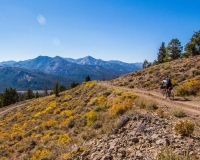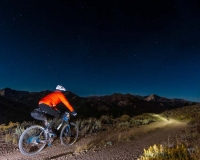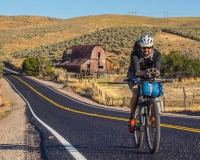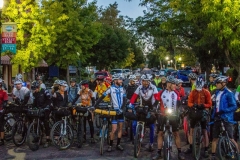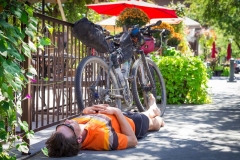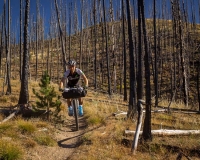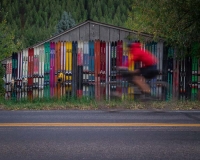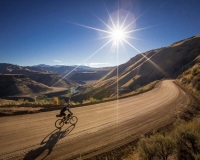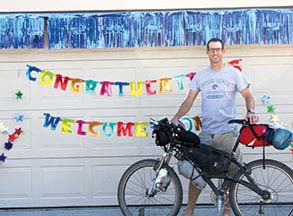No products in the cart.
Smoke ‘n’ Fire
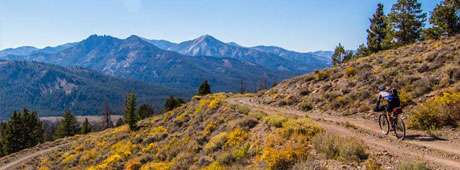
A 440-Mile Bikepacking Race
By Travis Armstrong
Photos by Robert Huguez Photography
It was a moment I hope never to forget. Near midnight on a crisp September night in the Idaho mountains, I had been perched on the seat of my mountain bike for nearly eighteen hours as I approached a major milestone on my journey. Within the last hour, I had crested the formidable Dollarhide Summit and now was descending the backside of the mountain. The eyes of coyotes and other creatures, glowing bright in my bicycle headlight, scattered to the left and right as I whipped down the dirt road, windy and steep, towards Ketchum. Despite carrying considerable speed, I couldn’t help but sneak glances up to the sky at the numerous brilliant stars. During one of these peeks, I saw a “shooting star” above the tree line. But that term doesn’t aptly describe the phenomenon. What I witnessed was a blazing fireball streaking across the eastern horizon. Although its descent through the atmosphere lasted only a second or two, the fiery meteor left an orange streak glowing across the sky. The streak slowly morphed into a smoky tail, similar to a jet trail high in the sky on a clear day. Over a period of what must have been twenty seconds, this smoky tail faded and ultimately floated away, leaving me with that memory I anticipate will remain emblazoned in my mind.
Still exhilarated after witnessing the fireball, I pulled into the city park in Ketchum at one in the morning to stretch my legs and consume some quick calories. I took a few minutes to reflect and absorb the day’s events. Along with approximately eighty other intrepid, if not mad, mountain bikers, I had set out from Hyde Park in Boise at six the previous morning in what was the second running of the Smoke ‘n’ Fire 400. It’s what is known as a bikepacking race, a form of cycling that melds mountain biking, backpacking, and bicycle touring. Lightweight camping gear and supplies are packed away in specially designed bags mounted to bikes in a streamlined fashion. With gear in tow, bikepackers are able to put together multi-day trips into the backcountry similar to what backpackers do.
The route traverses some of southern Idaho’s most beautiful backcountry. It’s actually 440 miles, beginning and ending in Boise as it connects Ketchum, Stanley, and Garden Valley primarily via backcountry roads and single-track trails. Along the way, participants get an intimate feel for southwestern Idaho, with views of the Sawtooth, Soldier, and Smoky Mountains, as well as riding along both Anderson Ranch and Deadwood Reservoirs. The route includes pit stops in a number of micro-towns, including Prairie, Pine, and Placerville.
A racer coasts down from Galena Pass during the inaugural race, 2014.
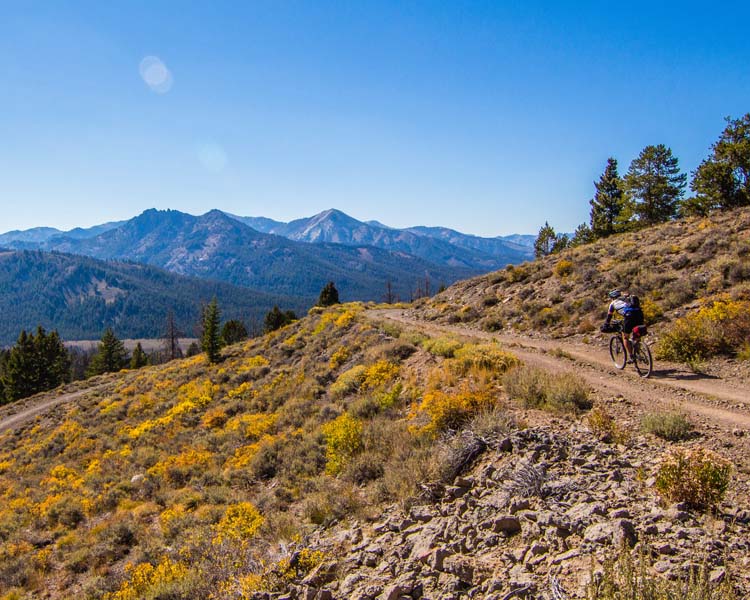
Blake Bockius heads toward Stanley from Galena Summit in the 2014 race.
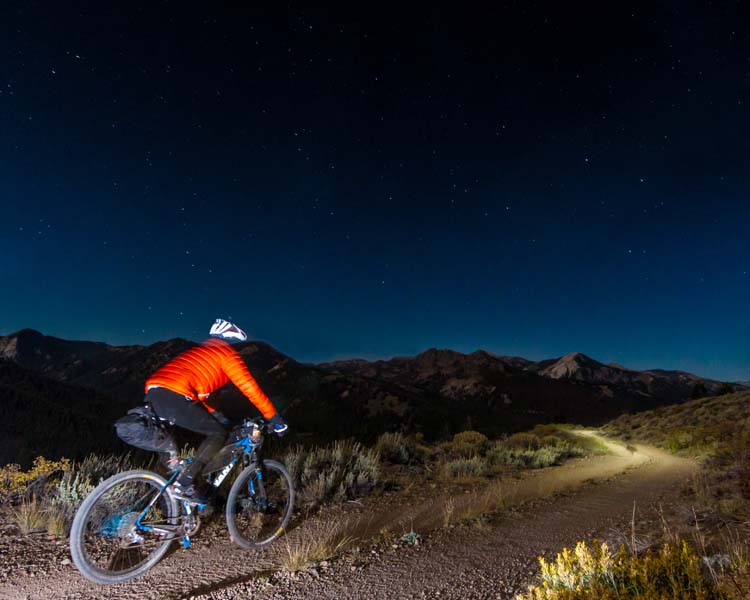
Greg Tovey leaves the Boise area on Blacks Creek Road, 2014.
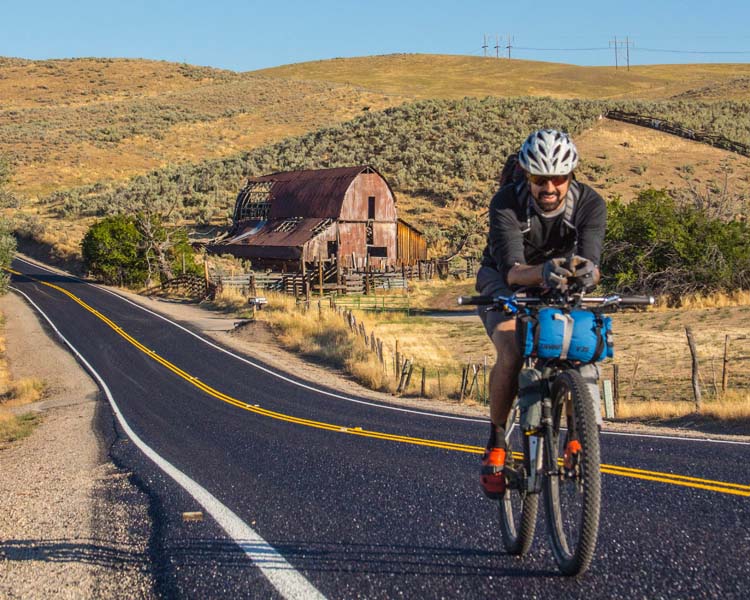
Riders at the start of the 2014 race.
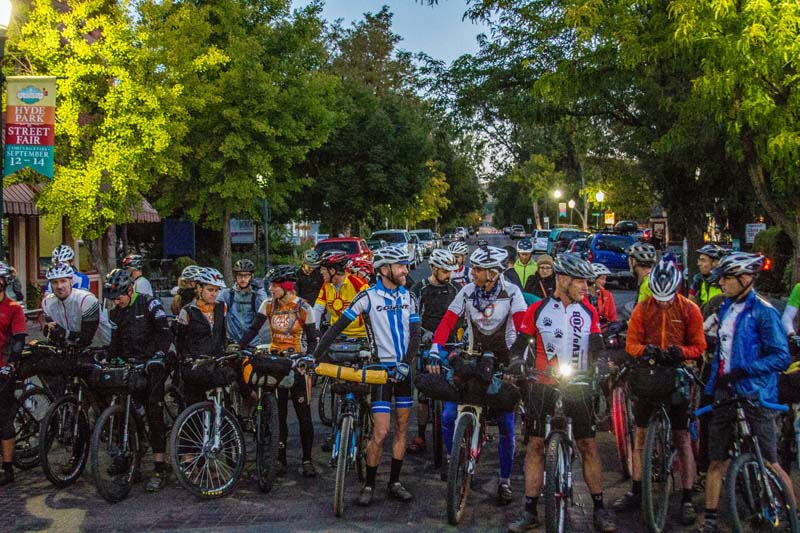
An exhausted competitor sleeps on the sidewalk at the finish, 2015.
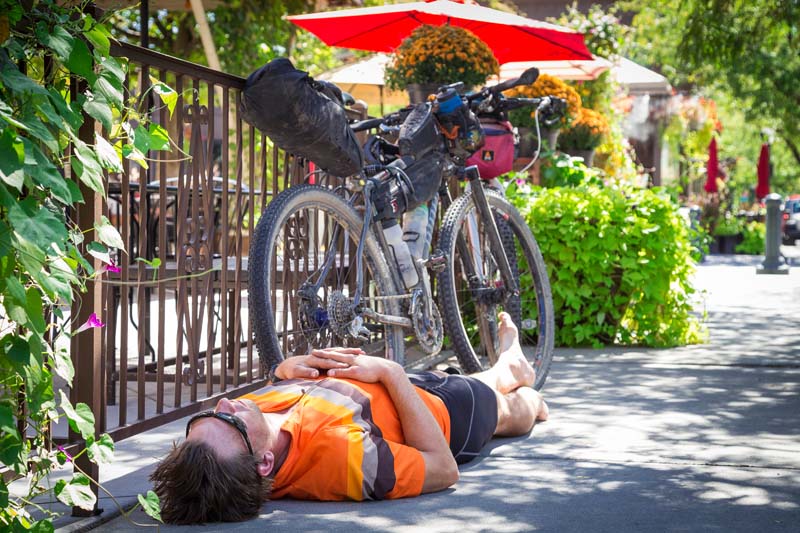
Eric Zuber rides the route’s Fisher Creek section, 2015.
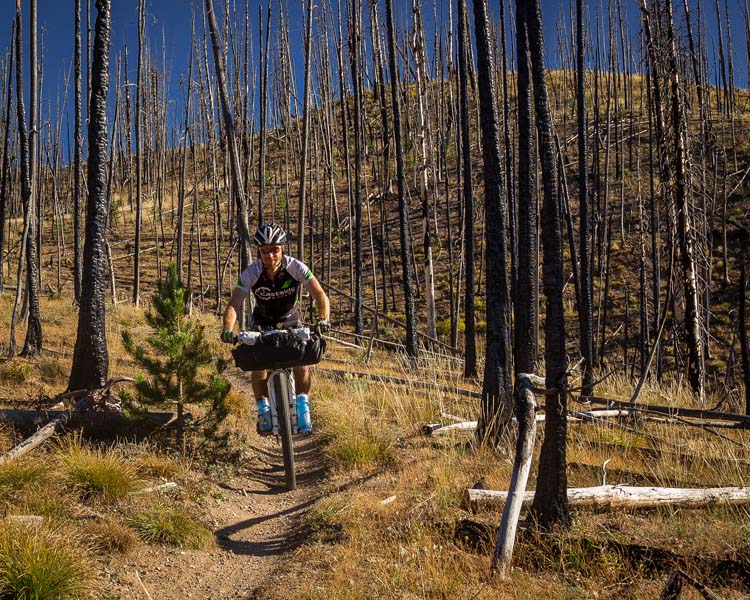
Rebecca Rusch approaches Stanley under the Sawtooth Range, 2015.
Sam Harney passes a fence made of skis, 2015.
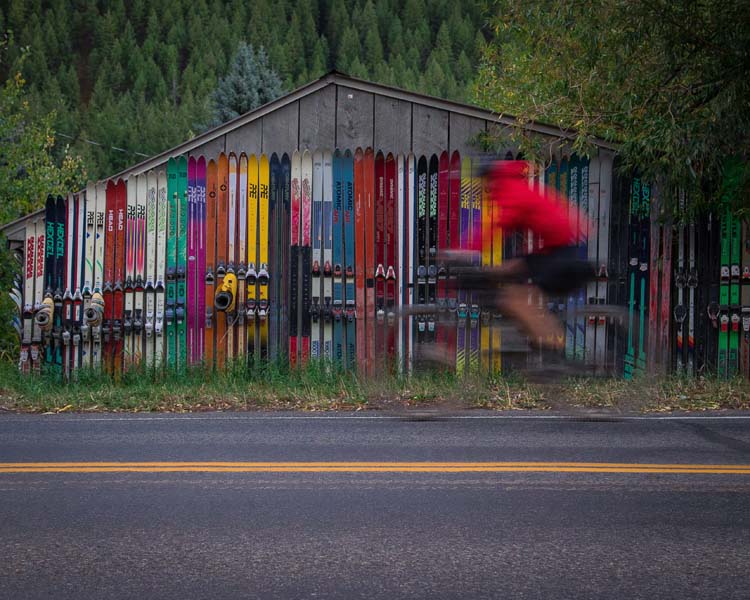
Travis Armstrong speeds above the Boise River in the 2015 Smoke ‘n’ Fire race.

The race was conceived and largely organized by Idaho native and Boise resident Norb Dekerchove, a man with a penchant for outdoor adventure and extreme endurance events. He has competed in ironman triathlons and has toured the western U.S. on adventure motorcycles, among other pursuits. But he shelved such passions in 2010, when he caught the bikepacking bug in a big way. That was the year he watched a film titled Ride the Divide, which documents the annual Tour Divide, the granddaddy of all bikepacking races. Participants start in Banff, Canada, and ride down through the U.S. along the Continental Divide all the way to the race’s terminus at the Mexican border. Just nine months after Norb saw the Tour Divide documentary, he competed in, and finished, the 2011 Tour Divide.
At that time, bikepacking races were springing up around the country, so Norb and mountain biking friend Tyson Fahrenbruck decided to organize a race in their Idaho backyard. They scouted out potential routes, which they considered as really just a great excuse to get out and explore the backcountry. Rather than staging a point-to-point race, they ultimately decided on a loop route, which would be logistically easier for racers. Through word of mouth and on a website, they attracted about thirty participants for the first race in 2014. In the second iteration last September, more than eighty people from eleven states and three countries turned out to take on the difficult course.
Bikepacking races such as the Smoke ‘n’ Fire are intended to follow a strict code of ethics. The name of the game is self-support. That means racers are not allowed to have any support or advantage not available to all participants. Typically, racers camp along the route in Spartan fashion, eating trail mix and gas station-type food purchased along the way. This said, a racer is allowed to pull into the Sun Valley Lodge and spend the night, starting out the next day after a professional massage and a full breakfast. However, a racer may not cache food or supplies along the route. As difficult as it is for family and friends, they are not allowed to meet racers along the way to provide any assistance or even moral support. One friend and fellow racer lamented to me that the route would take him within a stone’s throw of his summer cabin but that he couldn’t stop for a cozy night’s sleep, as this was outside the ethics of the race. Instead, he would cram his exhausted 6’-4” frame into his mummy bag and one-person tent for a cold night of sleep at a trailside pullout.
Sitting in the dark at the park in Ketchum, my body pulsing with caffeine and my brain awash in endorphins, I felt elated, as I had achieved a personal victory the previous day. Before setting out on the race, I had hoped to make it at least to Ketchum in one shot, without camping. Having never participated in an event like this, I was unsure if I could bike the 160 miles to Ketchum. Earlier in the day, I questioned if I even would make it to Fairfield without quitting.
The first half of the day had gone quite smoothly. Leaving Boise, I alternated between riding solo and alongside fellow racers while we chatted. Eighty miles into the race and feeling strong, I pulled into my first pit stop at the Pine convenience store. Camel-like, I took in lots of fluids, including a bottle of sugary cola. I left with my water bottles filled and a pepperoni sandwich stuffed in my jersey pocket.
Conscious of not losing too much time to my fellow competitors, I lit out of the store with a little too much eagerness to attack the next section of the race. From Pine, the route climbed steeply away from Anderson Ranch Reservoir up to what is known as Moore’s Flat. Knowing that I would burn lots of calories on the day ahead, I quickly ate my sandwich as I began the big climb. The temperature before I reached Pine had been perfect but now it was midday and the sun pounded me on the back. The suffering began. Whereas an hour earlier I was cranking on the pedals, now I pedaled just enough on the steep climb to keep my bike upright. As I swerved my way up the side of the road, I felt every pound of gear, food, and water packed on my bike. The sun’s intensity seemed to increase exponentially as I continued. In hindsight, it was completely predictable, but the cola and pepperoni sandwich combo was not a good idea. My stomach churned and soon I was dizzy and nauseous. Now three-quarters of the way up this seemingly never-ending ascent, I climbed off the saddle and began pushing the bike, with intervals of stopping and laying my heaving chest on my bike seat. During one of these rest stops, the contents of my aching stomach suddenly came up in violent fashion all over the side of the road. I felt for the riders behind me who would soon arrive at this putrid scene but, alas, it was out of my control.
Having expelled the contents of my stomach, I pressed on with a little more energy. I finally reached the top of the climb and turned to the east for what would be a long section of dry, dusty road through high desert ranchland. As tough as the climb out of Pine was, I had my Lawrence of Arabia moment as I rode through this desolate country. Most of my water had been blown through on the climb and there was no respite from the sun. No shade-providing trees as far as the eye could see, only the road winding through low sagebrush-covered hills. I felt like T.E. Lawrence crossing the Sinai Desert on his way to Cairo. Sunburned, lips chapped, throat parched. Doubt and dread crept into my head. The next opportunity for water and cell reception would not be until the town of Fairfield. many miles away. I seriously contemplated calling my wife Sarah upon arrival, assuming I could make it, and begging her to come pick me up. The thought of dropping out of the race was humiliating but I couldn’t wrap my mind around how I would complete such a long event when I was suffering so much, so early. Finally, I came over a rise to see some small brushy trees alongside a dried-up creek bed below me. Reaching the shade alongside the trees, I tossed my bike aside, plopped down in a half-fetal position, and fell asleep.
Occasionally, I cracked an eyelid as a racer rode past me, but my position in the race became irrelevant. I knew that victory in this competition would simply mean making it to the finish line back in Boise. Although my shady power nap lasted only a half-hour, the impact on my attitude was immense. I set out towards Fairfield with renewed vigor, which was bolstered when I rode up alongside my old friend Michael Devitt. Typically a chipper guy with a constant smile, he had been fighting his own battle. He feigned a positive attitude but obviously was spent. Conserving energy, we didn’t talk a lot, but having a friend in close proximity for the remainder of the ride into Fairfield helped considerably.
I left Fairfield well-hydrated and with a belly full of nutritious food. It was evening and the closer the sun approached the western horizon, the stronger I felt. Ketchum was still more than fifty miles away but now I was confident of making it. I had experienced a phenomenon common in bikepacking races: very intense mental highs and lows, sometimes separated only by minutes. In talking to fellow racers later, it became clear that we all experience this. The challenge is to weather the lows knowing that better mental and physical energy will be around the corner.
From Ketchum, the route headed north on the well-traveled Harriman Trail following the Big Wood River. I spent the rest of that first night of the race slowly winding my way north towards Galena Pass, the trail illuminated by a bright, battery-operated headlight. Well in front of me, in the Stanley Basin, quite a contest for first place was playing out. Three racers held a sizeable lead over the rest of the field. Among these cyclists was Idaho legend Rebecca Rusch. The forty-seven-year-old, long-time Ketchum EMT/firefighter is a world-renowned professional endurance athlete, known as the Queen of Pain.
At this point, Rusch was neck-and-neck with elite Boise racer Andy Stauffer. He had finished fourth in the inaugural Smoke ‘n’ Fire race and was bound and determined to win this year. In the mix with Stauffer and Rusch was an interesting character racing under the alias The Buffet. Early in the race, Stauffer held a large lead but Rusch and The Buffet reeled him in as they worked their way towards Stanley. After many miles in front, Stauffer finally ceded the lead to Rusch in dramatic fashion. Twenty-eight hours of riding with no sleep, coupled with the heat of the previous day, took a toll on Stauffer. Soon after completing a tough section of single-track trail, he fell asleep and tumbled off his bike. Fortunately, the accident happened at slow speed, so he was able to walk away without harm to himself or his bike. Feeling delirious, he began walking and pushing his bike, with the aim of making it to Redfish Lake Lodge for food and rest.
Rather than having racers beeline straight through the Stanley Basin along the highway, Norb Dekerchove had decided to make things interesting for the competitors. The route took riders east of the highway to complete a popular mountain bike trail loop called Fisher Creek. As if this detour weren’t enough, Norb decided he couldn’t let racers ride past stunning Redfish Lake on the highway. The route veered to the west, taking riders to Redfish Lake Lodge before returning to the highway for a few miles of blacktop riding.
During particularly difficult sections of the race, especially sections that detoured riders away from the shortest route to the next town for refuel, anguished cries of “Norb!” could be heard as the cyclists tried to direct their suffering elsewhere. But it was tongue in cheek, of course, because everyone appreciates the effort that goes into organizing such a race. There is no fee for participating in Smoke ‘n’ Fire. The reward for Norb and Tyson as race organizers is simply a sense of satisfaction.
While the race leaders leapfrogged through the Stanley Basin, my second day began with a climb over Galena Pass. The rest of the day was spent mostly winding through Stanley Basin before I pulled into the Stanley grocery store that evening to restock on food and water. As I mounted my bike to head out of town, I was ecstatic to see my good friend Mike Kauffman. Back in our bachelor, post-college days, he and I were roommates, and we had traveled around the West, taking up all kinds of outdoor adventures. Now living in Helena, Mike had traveled down to Boise to partake in the Smoke ‘n’ Fire.
Unfortunately, he had caught a cold the week before the race. To say that this was less than ideal would be quite an understatement. When I last had seen Mike twenty-four hours earlier, back in Fairfield, he was in a world of hurt. He was having a difficult time breathing and was even having chest pain. He had called his brother, who lives in Boise, and they had resolved to meet in Ketchum for a pick-up if Mike’s chest difficulties persisted. Given the state I had last seen him in, I was surprised not only to meet him in Stanley but to find him smiling and feeling energetic. I considered waiting for him as he restocked but instead opted to head out, as I wanted to hit the next section of the route before the sun set.
Rather than taking the easy route towards Cape Horn, Norb and Tyson once again had riders take the scenic detour. The course left the highway and skirted along Stanley Lake with majestic McGown Peak framed behind it. After a stout climb away from the lake, I turned onto a section of single track known as Elk Meadows. Unlike the smoothly flowing Fisher Creek Trail earlier in the day, Elk Meadows Trail was pockmarked with rocks and roots that rattled my joints and jostled my brain. Normally I love riding trails through heavy timber and meadows but this evening I longed for the boring, smooth blacktop of the highway just a few miles to the east. Alone in the woods with the setting sun, I cried out, “Norb!” through clenched teeth.
My hope for the night was to make it to Deadwood Reservoir. But fatigue was setting in, and I didn’t know if I had sixty more miles left in my legs. I had taken a few twenty- to thirty-minute naps throughout the previous day but now I was ready for some proper sleep. I felt if I could just make it to Deadwood, I could get some shut-eye, and then could set out for Boise in the morning with rested legs and the possibility of sleeping in my own bed Friday night. The miles came slowly as I made my way through Bear Valley, feeling a little sad that I was riding through such beautiful country in the dark. Earlier in the summer, I had scouted out the race route on motorcycle. The expansive meadows of Bear Valley and the salmon-filled Bear Valley Creek had been highlights for me.
After riding solo since Stanley, I was very grateful to hear the sound of another rider come up behind me. Mike Kauffman had caught up to me. The next couple of hours were among the best of the race for me. Just like old times, we rode together and swapped stories about our respective experiences during the race. Opportunities like this had become pretty rare since we had both settled down, started families, and now lived in different states. The miles flew by in chunks and soon we were at Deadwood Reservoir. I beelined for the nearest campground while Mike, feeling strong, pressed on.
It was three in the morning, and I hoped not to wake up the other campers as I unpacked my gear, made camp, and fell fast asleep. I awoke five hours later as the sun rose through the trees. Peering over my sleeping bag at the lakeside campground, I was surprised to see that I was the only person around. When I pulled in the night before, I was so tired and focused on getting sleep that I was unaware the campground was empty.
Boise was now within striking distance and I was feeling rested and motivated. Minutes after breaking camp. I came upon a massive bull elk anxiously herding a handful of cows along the lake’s shore. What a wonderful sight to start my day. I turned the cranks slowly, making my way up and over mountains and down the South Fork of the Payette River. In Garden Valley, I inhaled the best gas-station burrito of my life and in Placerville, I gassed up on caffeinated drinks. I was really missing my family and hoped that I could make it back to Boise before my eight-year-old daughter went to bed. Anyway, I was confident that even in a worst-case scenario I could be home in time to catch her soccer match the next morning. I love watching her play soccer and the thought of making it home in time for her match had provided a lot of motivation during my physical lows of the race.
As hard as I tried, the miles ticked by slowly as I wound my way up to Bogus Basin Ski Resort. By the time I got there, it was pitch-black and the city lights of Boise shone brightly below me. Although Boise was only forty-five minutes away via the paved road, Norb had riders take the road less traveled one last time. Knowing I was still a couple of hours away from the finish, I called my wife and told her that she should put our daughter to bed, as it would be quite late when I reached the finish line. After saying our goodnights, I slowly began winding my way down the Boise foothills by way of dirt road and trails.
With great pride, I rolled across the finish line just before eleven on Friday night, two days and seventeen hours after I had left from the same spot. A small but hearty group, including Norb and his wife Eve, had gathered at Hyde Park to greet finishers. Among this group were my buddies Andy Stauffer and Mike Kauffman, who had finished earlier in the day. Looking at me through bloodshot eyes, they gave blow-by-blow descriptions of their races, including when Andy fell asleep on his bike. Amazingly, he was able to rally and finish in seventh place. After Mike and I had parted ways at Deadwood Reservoir, he continued to ride through the night and finished in tenth place. Not bad for a guy with a cold. Adding to her already legendary status, Rebecca Rusch finished in second place, just over an hour behind twenty-seven-year old Sam “The Buffett” Harney, twenty years her junior.
Stiff and sore, I cheered on my daughter the next day at her soccer match. Standing on the sideline, my thoughts frequently took me back to the race, and I found myself feeling an immense sense of gratitude. I was grateful for the beautiful Idaho public land I had just traveled through, and grateful for Idahoans like Norb and Tyson, who helped motivate us to get out and recreate in it.
Editor’s Note: The author placed twelfth among fifty finishers in the 2015 race. The 2016 race will begin September 14. For information, visit smokenfire420.wordpress.com.
This content is available for purchase. Please select from available options.
Register & Purchase Purchase Only
Register & Purchase Purchase Only

